Navy
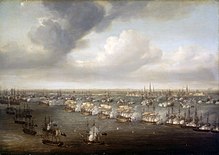

A navy, naval force, military maritime fleet, war navy, or maritime force is the
The strategic offensive role of a navy is
Etymology and meanings
First attested in English in the early 14th century,[1] the word "navy" came via Old French navie, "fleet of ships", from the Latin navigium, "a vessel, a ship, bark, boat",[2] from navis, "ship".[3] The word "naval" came from Latin navalis, "pertaining to ship";[4] cf. Greek ναῦς (naus), "ship",[5] ναύτης (nautes), "seaman, sailor".[6] The earliest attested form of the word is in the Mycenaean Greek compound word 𐀙𐀄𐀈𐀗, na-u-do-mo (*naudomoi), "shipbuilders", written in Linear B syllabic script.[n 1]
The word formerly denoted fleets of both commercial and military nature. In modern usage "navy" used alone always denotes a military fleet, although the term "
History
This section needs additional citations for verification. (November 2018) |
Naval warfare developed when humans first fought from water-borne vessels. Before the introduction of the

The mass and
The development of large capacity, sail-powered ships carrying cannon led to a rapid expansion of

Throughout the 18th century the Royal Navy gradually gained ascendancy over the French Navy, with victories in the
The next stage in the evolution of naval warfare was the introduction of metal plating along the hull sides. The increased mass required steam-powered engines, resulting in an arms race between armor and weapon thickness and firepower. The first armored vessels, the French Gloire and British HMS Warrior, made wooden vessels obsolete. Another significant improvement came with the invention of the rotating turrets, which allowed the guns to be aimed independently of ship movement. The battle between CSS Virginia and USS Monitor during the American Civil War (1861–1865) is often cited as the beginning of this age of maritime conflict. The Russian Navy was considered the third strongest in the world on the eve of the Russo-Japanese War, which turned to be a catastrophe for the Russian military in general and the Russian Navy in particular. Although neither party lacked courage, the Russians were defeated by the Japanese in the Battle of Port Arthur, which was the first time in warfare that mines were used for offensive purposes. The warships of the Baltic Fleet sent to the Far East were lost in the Battle of Tsushima. A further step change in naval firepower occurred when the United Kingdom launched HMS Dreadnought in 1906, but naval tactics still emphasized the line of battle.

The first practical military
A major paradigm shift in naval warfare occurred with the introduction of the aircraft carrier. First at Taranto in 1940 and then at Pearl Harbor in 1941, the carrier demonstrated its ability to strike decisively at enemy ships out of sight and range of surface vessels. The Battle of Leyte Gulf (1944) was arguably the largest naval battle in history; it was also the last battle in which battleships played a significant role. By the end of World War II, the carrier had become the dominant force of naval warfare.
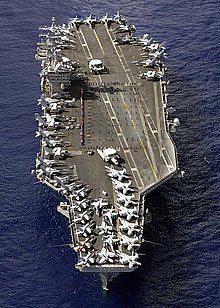
World War II also saw the United States become by far the largest naval power in the world. In the late 20th and early 21st centuries, the United States Navy possessed over 70% of the world's total numbers and total tonnage of naval vessels of 1,000 tons or greater.[17] Throughout the rest of the 20th century, the United States Navy would maintain a tonnage greater than that of the next 17 largest navies combined. During the Cold War, the Soviet Navy became a significant armed force, with large numbers of large, heavily armed ballistic missile submarines and extensive use of heavy, long-ranged antisurface missiles to counter the numerous United States carrier battle groups. Only two nations, the United States and France, presently operate CATOBAR carriers of any size, while Russia, China and India operate sizeable STOBAR carriers (although all three are originally of Russian design). The United Kingdom is also operating two Queen Elizabeth-class carriers, which are the largest STOVL vessels in service, and India is currently building one aircraft carrier, INS Vikrant, and considering another. France is also looking at a new carrier, probably using a CATOBAR system and possibly based on the British Queen Elizabeth design.
Operations

A navy typically operates from one or more naval bases. The base is a port that is specialized in naval operations, and often includes housing, a munitions depot, docks for the vessels, and various repair facilities. During times of war temporary bases may be constructed in closer proximity to strategic locations, as it is advantageous in terms of patrols and station-keeping. Nations with historically strong naval forces have found it advantageous to obtain basing rights in other countries in areas of strategic interest.
Navy ships can operate independently or with a group, which may be a small squadron of comparable ships, or a larger naval fleet of various specialized ships. The commander of a fleet travels in the flagship, which is usually the most powerful vessel in the group. Before radio was invented, commands from the flagship were communicated by means of flags. At night signal lamps could be used for a similar purpose. Later these were replaced by the radio transmitter, or the flashing light when radio silence was needed.
A "
Traditions
A basic tradition is that all ships commissioned in a navy are referred to as ships rather than vessels, with the exception of destroyers and submarines, which are known as boats. The prefix on a ship's name indicates that it is a commissioned ship.
The ship's captain, and more senior officers are "piped" aboard the ship using a Boatswain's call.
In the United States, the First Navy Jack is a flag that has the words, "Don't Tread on Me" on the flag.
By English tradition, ships have been referred to as a "she". However, it was long considered bad luck to permit women to sail on board naval vessels. To do so would invite a terrible storm that would wreck the ship. The only women that were welcomed on board were figureheads mounted on the prow of the ship.
Firing a cannon salute partially disarms the ship, so firing a cannon for no combat reason showed respect and trust. As the tradition evolved, the number of cannon fired became an indication of the rank of the official being saluted.
Ships
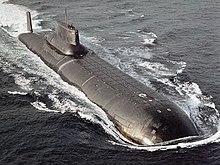

Historically, navy ships were primarily intended for warfare. They were designed to withstand damage and to inflict the same, but only carried munitions and supplies for the voyage (rather than merchant cargo). Often, other ships which were not built specifically for warfare, such as the galleon or the armed merchant ships in World War II, did carry armaments. In more recent times, navy ships have become more specialized and have included supply ships, troop transports, repair ships, oil tankers and other logistics support ships as well as combat ships.
Modern navy combat ships are generally divided into seven main categories:
Naval ship names are typically prefixed by an abbreviation indicating the national navy in which they serve. For a list of the prefixes used with ship names (
.Today's warships are significantly faster than in years past, thanks to much improved propulsion systems. Also, the efficiency of the engines has improved, in terms of fuel, and of how many sailors it takes to operate them. In World War II, ships needed to refuel very often. However, today ships can go on very long journeys without refueling. Also, in World War II, the engine room needed about a dozen sailors to work the many engines, however, today, only about 4–5 are needed (depending on the class of the ship). Today, naval strike groups on longer missions are always followed by a range of support and replenishment ships supplying them with anything from fuel and munitions, to medical treatment and postal services. This allows strike groups and combat ships to remain at sea for several months at a time.
Boats
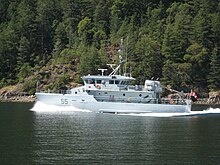
The term "boat" refers to small craft limited in their use by size and usually not capable of making lengthy independent voyages at sea. The old navy adage to differentiate between ships and boats is that boats are capable of being carried by ships. (Submarines by this rule are ships rather than boats, but are customarily referred to as boats reflecting their previous smaller size.)
Navies use many types of boat, ranging from 9-foot (2.7 m) dinghies to 135-foot (41 m) landing craft. They are powered by either diesel engines, out-board gasoline engines, or waterjets. Most boats are built of aluminum, fiberglass, or steel.
Patrol boats are used for patrols of coastal areas, lakes and large rivers.

Landing craft are designed to carry troops, vehicles, or cargo from ship to shore under combat conditions, to unload, to withdraw from the beach, and to return to the ship. They are rugged, with powerful engines, and usually armed. There are many types in today's navies including hovercraft. They will typically have a power-operated bow ramp, a cargo well and after structures that house engine rooms, pilot houses, and stowage compartments. These boats are sometimes carried by larger ships.
Special operations craft are high-speed craft used for insertion and extraction of special forces personnel and some may be transportable (and deployed) by air.
Boats used in non-combat roles include lifeboats, mail boats, line handling boats, buoy boats, aircraft rescue boats, torpedo retrievers, explosive ordnance disposal craft, utility boats, dive boats, targets, and work boats. Boats are also used for survey work, tending divers, and minesweeping operations. Boats for carrying cargo and personnel are sometimes known as launches, gigs, barges or shore party boats.
Units
Naval forces are typically arranged into units based on the number of ships included, a single ship being the smallest operational unit. Ships may be combined into squadrons or flotillas, which may be formed into fleets. The largest unit size may be the whole Navy or Admiralty.
A task force can be assembled using ships from different fleets for an operational task.

Personnel
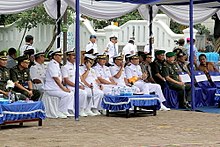
Despite their acceptance in many areas of naval service, female sailors were not permitted to serve on board U.S. submarines until the U.S. Navy lifted the ban in April 2010.[18] The major reasons historically cited by the U.S. Navy were the extended duty tours and close conditions which afford almost no privacy. The United Kingdom's Royal Navy has had similar restrictions. Australia, Canada, Norway, and Spain previously opened submarine service to women sailors.[19]
Ranks
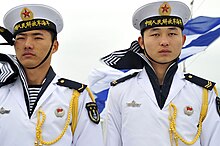

A navy will typically have two sets of ranks, one for enlisted personnel and one for officers.
Typical ranks for commissioned officers include the following, in ascending order (Commonwealth ranks are listed first on each line; USA ranks are listed second in those instances where they differ from Commonwealth ranks):
- Corvette Lieutenant
- Frigate Lieutenant
- Captain Lieutenant
- Corvette Captain
- Frigate Captain
- Ship-of-the-Line Captain
- Rear Admiral (lower half))
- Rear Admiral (upper half))
- Vice Admiral(Commonwealth & USA)
- Admiral (Commonwealth & USA)
- Grand Admiral
"Flag officers" include any rank that includes the word "admiral" (or commodore in services other than the US Navy), and are generally in command of a
The most senior rank employed by a navy will tend to vary depending on the size of the navy and whether it is wartime or peacetime, for example, few people have ever held the rank of Fleet Admiral in the U.S. Navy, the chief of the Royal Australian Navy holds the rank of Vice Admiral, and the chief of the Irish Naval Service holds the rank of Commodore.

Naval infantry, commonly known as marines, are a category of infantry that form part of a state's naval forces and perform roles on land and at sea, including amphibious operations, as well as other, naval roles. They also perform other tasks, including land warfare, separate from naval operations.
During the era of the

The Spanish
In the majority of countries, the marine force is an integral part of the navy but there are variations such as the French Troupes de marine which is actually part of the French Army. The United States Marine Corps is a separate armed service within the United States Department of the Navy, with its own leadership structure.

Naval aviation is the application of military air power by navies, whether from warships that embark aircraft, or land bases.
In World War I several navies used
Naval aviation forces primarily perform naval roles at sea. However, they are also used in a variety of other roles.
Further reading
- Non-fiction:
- Combat Fleets of the World: Their Ships, Aircraft and Systems - Naval Institute Press. Published annually. Comprehensive.
- Braudel, Fernand, The Mediterranean in the Ancient World
- Corbett, Sir Julian, Some Principles of Maritime Strategy, 1911.
- Hughes, Jr., Wayne P., Fleet Tactics and Coastal Combat, 1999, Naval Institute Press, ISBN 1-55750-392-3
- ISBN 0-394-54674-1
- Mahan, Alfred Thayer, The Influence of Sea Power upon History, 1660-1783, 1918, Little Brown, Boston.
- Marder, Arthur. The Anatomy of British Seapower. New York: Octagon Books, 1940.
- Marder, Arthur. "The Influence of History on Sea Power: The Royal Navy and the Lessons of 1914-1918", Pacific Historical Review. November, 1972.
- Richmond, Herbert. National Policy and National Strength and other Essays. London: Longman, Green and Co., 1928.
- Sprout, Harold and Margaret Sprout. Toward a New Order of Sea Power: American Naval Policy ... 1918-1922. Princeton: Princeton University Press, 1940.
- Starr, Chester G., The Influence of Sea Power on Ancient History, 1989, Oxford University Press, ISBN 0-19-505666-3
- Tangredi, Sam, "Globalization and Maritime Power", 2002 - ISBN 1-57906-060-9
- Trafalgar 200 Through the Lens, ISBN 0-9553004-0-1
- Wombacher, Joerg and Joerg Felfe. (2012) United We Are Strong: An Investigation into Sense of Community among Navy Crews, Armed Forces & Society, Vol. 38, No. 4
- ISBN 1-884733-06-9
- Fiction:
- Alan Lewrie series by Dewey Lambdin
- Aubrey–Maturin series by Patrick O'Brian
- Horatio Hornblower series by C. S. Forester
- Richard Bolitho series by Alexander Kent (Pseudonym of Douglas Reeman)
- Tom Clancy, The Hunt for Red October, Red Storm Rising
See also
- Blue-water navy
- Coast guard
- List of auxiliary ship classes in service
- List of countries by level of military equipment
- List of naval battles
- List of naval ship classes in service
- List of navies
- List of submarine classes in service
- Marines
- Naval fleet
- Naval militia
- Naval tactics
- Naval warfare
- Navies of landlocked countries
- Shore patrol
Notes
References
- ^ Harper, Douglas. "navy". Online Etymology Dictionary.
- Perseus Project.
- Perseus Project.
- Perseus Project.
- Perseus Project.
- ^ ναύτης in Liddell and Scott.
- ^ "The Linear B word na-u-do-mo". Palaeolexicon. Word study tool of ancient languages.
- ^ Raymoure, K.A. "na-u-do-mo". Minoan Linear A & Mycenaean Linear B. Deaditerranean. Archived from the original on 2013-10-13. Retrieved 2014-03-25.
- ^ "KN 736 U (unknown)". "PY 568 Na (1)". "PY 865 Vn + fr. (Ci)". "PY 990 Xn (unknown)". DĀMOS: Database of Mycenaean at Oslo. University of Oslo. Archived from the original on 2014-03-25.
- ^ ναυπηγός.
- ^ Kumar, Ann (2012). 'Dominion Over Palm and Pine: Early Indonesia's Maritime Reach', in Geoff Wade (ed.), Anthony Reid and the Study of the Southeast Asian Past (Singapore: Institute of Southeast Asian Studies), 101–122.
- ISBN 978-602-9346-00-8.
- ^ Hill (June 1960). "Hikayat Raja-Raja Pasai". Journal of the Malaysian Branch of the Royal Asiatic Society. 33: p. 98 and 157: "Then he directed them to make ready all the equipment and munitions of war needed for an attack on the land of Pasai – about four hundred of the largest junks, and also many barges (malangbang) and galleys." See also Nugroho (2011). p. 270 and 286, quoting Hikayat Raja-Raja Pasai, 3: 98: "Sa-telah itu, maka di-suroh baginda musta'idkan segala kelengkapan dan segala alat senjata peperangan akan mendatangi negeri Pasai itu, sa-kira-kira empat ratus jong yang besar-besar dan lain daripada itu banyak lagi daripada malangbang dan kelulus." (After that, he is tasked by His Majesty to ready all the equipment and all weapons of war to come to that country of Pasai, about four hundred large jongs and other than that much more of malangbang and kelulus.)
- ^ Nugroho (2011), p. 271, 399–400, quoting Sejarah Melayu, 10.4: 77: "... maka bagindapun segera menyuruh berlengkap tiga ratus buah jung, lain dari pada itu kelulus, pelang, jongkong, tiada terbilang lagi." (then His Majesty immediately ordered to equip three hundred jong, other than that kelulus, pelang, jongkong in uncountable numbers.)
- ^ Leyden, John (1821). Malay Annals: Translated from the Malay language. London: Longman, Hurst, Rees, Orme and Brown. p. 86: "The bitara immediately fitted out 300 junks together with the vessels calúlús, pelang, and jongkong in numbers beyond calculation, and embarked on board of them two Cati of Javans (200,000). Then having set sail, they arrived at Singhapura, and immediately engaged in battle."
- S2CID 247335671.
- ^ Weighing the US Navy Defense & Security Analysis, Volume 17, Issue December 3, 2001, pp 259-265
- ^ "The Associated Press: Biden notes big year, sub service for Navy women". 1 June 2010. Archived from the original on 1 June 2010.
- ^ "NATO Review - Vol. 49 - No 2 - Summer 2001". NATO. Archived from the original on 2021-04-28. Retrieved 2021-03-22.
External links
- Naval Technology - News, projects, images and white papers on the naval industry
- NOSI (Naval Open Source Intelligence) - a library of world naval operational news
- Navy at Scottish Military Heritage Centre
- . Collier's New Encyclopedia. 1921.
- Hannay, David McDowall (1911). . Encyclopædia Britannica. Vol. 19 (11th ed.). pp. 299–317.
